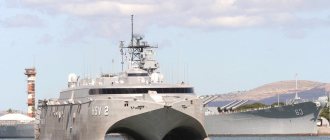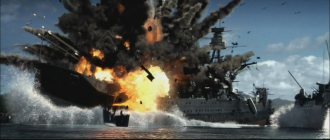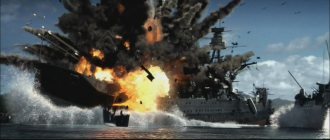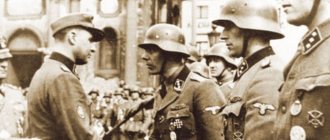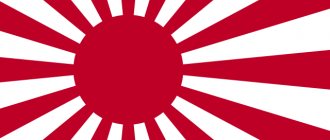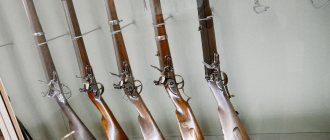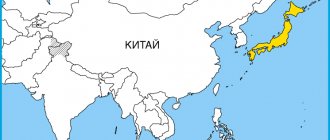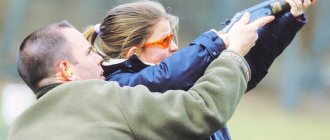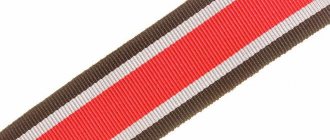Pearl Harbor is a bay on the Hawaiian island of Oahu, which is used as a US Navy base. There are many US fleet bases not only in America itself, but throughout the world. But in fact, only this one is widely known. Pearl Harbor gained this widespread fame after Japan attacked this base and destroyed a large number of enemy ships, aircraft and manpower. On the one hand, this allowed Japan to neutralize US activity in the Pacific region for a whole six months and seize significant territories. On the other hand, by leaving the enemy’s infrastructure unattended, Japan made it possible to relatively quickly restore the combat capability of the American fleet, which served, literally six months later, as the reason for the defeat of the very forces that could completely destroy the US Navy in the Pacific.
According to one version, the Soviet spy Richard Sorge contributed to this attack. It was this fact that prevented the Soviet authorities from recognizing him as their intelligence officer in order to avoid accusations that they were actually fighting against the United States.
- Pearl Harbor.
- Nuclear missiles.
- Submarine.
- Travel time.
- Distance traveled.
Pearl Harbor ⇧
After Waikiki Beach we went to Pearl Harbor. By the way, I thought that the Japanese didn’t go there much, but in vain. There were plenty of them there. In general, an interesting park-museum with exhibits and photographs describing events. We didn't get on the ships or submarine.
Nuclear missiles ⇧
Submarine ⇧
We looked at a Japanese kamikaze torpedo boat. By the way, it is written that a person could leave the torpedo 50 meters before the target, but it is believed that no one did this, and in total more than a hundred died, some of whom died during training! (get carried away?) Generally speaking, the Americans also used, in fact, the same tactics in response - they sent planes to bomb Tokyo with the same American kamikazes - the planes only had fuel one way.
We didn’t dare go to Kaena Point State Park, although we seemed to have time.
Then we returned the car and flew to Alaska!
Why did the Japanese attack Pearl Harbor on December 7, 1941?
Over Pearl Harbor, December 7, 1941. Ford Island and American battleships at the piers are visible
The title contains a very popular question that arises among those who are superficially familiar with the topic - from cinema and fiction. In fact, the US naval base Pearl Harbor in Hawaii is very far from the coast of Japan and warships from here can go to any direction in the world, as they say in games “across half the map.” The Japanese had to have a very good reason to carry out this attack... and of course there was such a reason, or rather, a whole bunch of reasons.
Japan, as an island state, was simply obliged to have a powerful modern fleet. And such a fleet needs fuel, a lot, a lot of fuel. While Japan was closely “friends” with Great Britain (both against Russia and against the United States), it regularly received oil from it at bargain prices. But by the 1930s the friendship had ended, but the need remained. In general, there was only one solution - rough, but simple - to take away the oil fields from the neighbors, especially since they were located literally nearby - in Indonesia (then the East Indies).
Local and colonial troops and navies were inferior to the Japanese both in numbers and in military power, so the expansion was initially very successful - in the shortest possible time, most of Southeast Asia and Oceania were “under Japan.” And now it’s time to look at the map again. And to answer the question - if you were in Japan’s place, you were assessing the threats to your dominance in Asia, where do you think they would come from? Considering that you had already captured all the more or less significant military bases in Asia a year earlier?
US Naval Base Pearl Harbor on the world map
As you can see, Pearl Harbor no longer seems to be on the outskirts of the world, outside the sphere of Japanese interests. Moreover, it is this naval base (or rather the fleet stationed at its roadstead) that poses a clear threat that must be eliminated as quickly as possible. Considering the alliance of European powers and the United States, this “gun” would definitely fire in the very near future, hence the treacherous impudence, hence the haste.
However, if everything is more or less clear about the reason for the attack on Pearl Harbor, one important point remains unclear - why, if Hawaii was such an important point on the map, did the Japanese simply not carry out a landing operation and capture the islands?
This will sound a little strange, but the attack on Pearl Harbor itself was intended only as an auxiliary operation, one of the links in a large chain to provide Japan with oil resources. Hawaii was seen as an important goal, but a secondary one - given the scale with which Japan was fighting (almost a quarter of the globe!), at this stage it simply did not have the military resources to hold the islands.
At the same time, the main strategic goal of the operation was largely achieved - the US Pacific Fleet was temporarily put out of action and could not interfere with the free march of Japanese soldiers across the islands of Oceania.
And as soon as Japan’s power over Oceania became more or less strong (no more than six months was enough for this), the Imperial Navy was not slow in coming to Hawaii again, this time in full force and bringing with it transport barges with paratroopers.
Expansion of Japan's sphere of influence on the eve of the Pacific War
But on June 4-6, in the battle for Midway Island (on the map it is slightly north of the Pearl Harbor base), Japan suffered a crushing defeat from the US Navy, in which it lost 4 of its 6 heavy aircraft carriers, and with them the hope of retaining its Pacific possessions.
Ironically, the main damage to the Japanese fleet was inflicted by the air groups of the aircraft carriers Enterprise and Yorktown (the latter was sunk in the same battle) - the same ones that Admiral Nagumo's squadron missed by a few hours six months earlier, by a lucky coincidence, not caught them in the harbor.
Source: compilation based on information from open sources
Attack on Pearl Harbor (1941). Reference
The American Pacific Fleet, under the command of Admiral Husband Kimmel, located at the Pearl Harbor naval base, consisted of 93 ships, including nine battleships (one training), eight cruisers, 29 destroyers, five submarines, nine destroyers and minelayers, 10 minesweepers. There were 390 aircraft located at the airfields on Oahu, including 167 naval aircraft.
The base's air defense consisted of 188 anti-aircraft guns, more than 100 machine gun installations and five radar stations. The garrison, under the command of General William Short, numbered 42,959 men.
Japan began preparations for the operation in January 1941 with the strictest secrecy. Even Japan’s allies – Germany and Italy – were not aware of its goals and date. The ships' route practically excluded encounters with commercial and fishing vessels and was beyond the range of American patrol aircraft. During the transition, radio silence was strictly observed; at the same time, radio exchange was carried out in the Inland Sea of Japan using the call signs of those ships that were heading to the Hawaiian Islands in order to disorient the enemy.
On the evening of December 6, Japanese submarines took up their initial positions on the nearest approaches to the island of Oahu and at 23:00 they began launching midget submarines. On December 7, a Japanese aircraft carrier force entered the area located 275 miles (about 450 km) north of the island.
It was Sunday. Some of the personnel of the American ships were on the shore. The entrance to Pearl Harbor was not closed with booms (floating barriers), and there was also no anti-torpedo net barrier for the battleships. The disposition of the ships did not change for a long time. The planes at the airfields were crowded together; on the approaches to the Hawaiian Islands, aerial reconnaissance was carried out only sporadically.
The Japanese General Staff, on the contrary, had comprehensive data on the disposition of American ships and the state of the base’s defense.
On December 7, at 6:15 a.m. Hawaiian time, 40 torpedo bombers, 49 bombers, 51 dive bombers, and 43 fighters took off from Japanese aircraft carriers. The raid on the base began at 7:55 am. At 9:15 a.m. the second group of aircraft struck (54 bombers, 78 dive bombers, 35 fighters). The entire raid on the base lasted 2 hours 5 minutes.
Four battleships, a cruiser, two destroyers, several auxiliary ships and 188 aircraft were destroyed. Four battleships, three light cruisers, a destroyer, two auxiliary vessels and over 100 aircraft were damaged. American casualties amounted to 3,581 people.
The Japanese lost 29 aircraft and six submarines (of which five were midgets), and over 70 aircraft were damaged.
As a result of the Hawaiian operation and the subsequent Philippine and Malayan operations of 1941–1942. Japan gained supremacy at sea and gained freedom of action in the Pacific Ocean.
With a surprise attack on an American military base, Japan started a war against the United States. On December 8, the USA, Great Britain, Canada and a number of other countries declared war on Japan.
The success of the Hawaiian operation was due to the careful preparation of the Japanese command for the operation, the precise organization of the covert passage of ships and the surprise of the attack. The American command made mistakes in organizing the defense of the main fleet base and assessing the situation as a whole.
The operation showed the high combat capabilities of aircraft carriers, while midget submarines did not justify themselves.
US President Franklin Roosevelt called December 7, 1941 “a day of indelible shame.” The slogan “Remember Pearl Harbor” became the leading slogan in the American war against Japan.
After 1945, the Pearl Harbor naval base was reconstructed and again began to serve as the main base of the US Pacific Fleet.
A memorial dedicated to the battleship Arizona, sunk by Japanese aircraft, was opened in Pearl Harbor. (Additional source: Military Encyclopedia. Chairman of the Main Editorial Commission S.B. Ivanov. Military Publishing House. Moscow. in 8 volumes - 2004).
The material was prepared based on information from open sources
Pearl Harbor (36 photos)
Pearl Harbor is a pearl harbor located on the island of Oahu, in Hawaii. This island is the site of global tragic events, and later the filming location for many famous films.
Today Pearl Harbor serves as a museum. Here you can visit the battleship Missouri and honor the memory of those killed by visiting the Arizona Memorial.
From the shore you can see the sunken battleship Arizona, the upper deck of which is overgrown with corals. At the time of the sinking, there were almost two million liters of fuel on board the Arizona, which to this day flows drop by drop onto the surface of the water. Legends say that “black tears” on the water will be visible until the last survivor of the ship’s crew dies.
Highway in the mountains of the Hawaiian island of Oahu near the Pearl Harbor naval base
Embankment with a fountain and parking on the territory of the naval base
Aerial view of Oahu harbor at the memorial site
Surfers on the waves off the coast of Oahu in Pearl Harbor
The remains of the battleship Arizona above the waves in Pearl Harbor
Archival photo of the Pearl Harbor base before the attack in 1941
Helicopter over Pearl Harbor Naval Base
Sunset over the Oahu resort in Pearl Harbor
Aircraft carrier in port at Pearl Harbor
Top view of a modern American battleship in Pearl Harbor
Mountains of the Hawaiian island of Oahu in Pearl Harbor
Beach at Hanauma Bay on the Hawaiian island of Oahu
Bird's eye view of Oahu island and harbor bay
US Pacific military base Pearl Harbor
File photo of a sunken ship in Pearl Harbor
Hawaiian palm tree over the Pearl Harbor memorial ship
File photo of destruction on the pier after the attack in the harbor
Tourists on Waimea Beach on the west coast of Oahu
Memorial observation deck in honor of the sunken battleship Arizona
Pearl Harbor War Memorial
Dry dock at Pearl Harbor naval base
Helicopters over the Pearl Harbor memorial
The deck of an aircraft carrier in the panorama of Pearl Harbor
Port of the Pearl Harbor military base on the island of Oahu
Naval base Pearl Harbor on the Hawaiian island of Oahu
Evening lights of shipyards and docks in Pearl Harbor
Panorama of Pearl Harbor
Battleship Missouri in the Pearl Harbor panorama
Tourist boats at the Pearl Harbor memorial
Tourist on the beach of Oahu island in Pearl Harbor
Ship at Pearl Harbor military base in Hawaii
Modern warship in Pearl Harbor
Warships at the Pearl Harbor Memorial
Tourists at the entrance to the Pearl Harbor Memorial
Boats off the coast of Oahu island in Hawaii
American flag over the Arizona Memorial in Pearl Harbor
See also:
Tower (37 photos)
Photos of beautiful places
Hawaii (36 photos)
PEARL HARBOR
American warships in Pearl Harbor after a Japanese air strike on December 7, 1941. Photo.
PEARL HARBOR, Pearl Harbor (Pearl Harbor, translated from English. Pearl Harbor), bay (bay) of the Pacific Ocean approx. to the south coast of the island Oahu is part of the Hawaiian Islands (state of Hawaii, USA), approximately 10 km west of Honolulu. It has a complex branched shape, divided by two peninsulas and an island. Ford into smaller bays (West Lough, Middle Lough, East Lough), reaching at its widest point approx. 9.5 km. To the south parts of the narrow strait (width about 400 m) communicates with the Pacific Ocean. Mamala.
Briton was first described. expedition of N. Portlock in 1786, studied in detail by the expedition of Charles Malden in 1824. In 1887, the king of the Hawaiian kingdom Kalakaua I transferred the exception. rights to use the bay to the United States. In 1908, the US Congress decided to build in P.-Kh. naval base (opened in 1911). Since July 1941, the headquarters of the US Pacific Fleet has been located.
12/7/1941 attack on P.-Kh. Japan started the war in the Pacific ca. (see Pacific campaigns 1941–45). By this time in P.-Kh. there were ch. forces of the US Pacific Fleet, including 8 battleships, 8 cruisers, 29 destroyers (more than 160 ships in total). The air force base consisted of 394 aircraft. Japanese plan of attack on P.-Kh. was actively developed under hand. adm. I. Yamamoto from January 7, 1941, approved by the Japanese government and the Emperor on November 5, 1941. His ch. strategic the goal was to eliminate Amer. fleet as an obstacle to Japanese expansion in the Southeast. Asia. 26 Nov Japanese aircraft carrier formation [command. – Vice Adm. T. Nagumo; a total of 33 ships, including 2 battleships, 6 aircraft carriers with 423 aircraft, 3 cruisers, 11 destroyers, 3 submarines;] left Bidokap Bay (Hitokappu; Iturup Island). The general management of the United Fleet was carried out by Adm. Yamamoto. At dawn 7 Dec. (occurred on Sunday; Tokyo time on the night of December 8) the aircraft carrier force reached a line of 275 miles (approx. 450 km) north of the island. Oahu. In addition, near P.-Kh. was deployed St. 20 Japanese Submarines (had 5 ultra-small submarines on board). Raised from Japanese. aircraft carriers aircraft in two echelons [183 aircraft in the first, 167 (according to other data, 170 or 171) in the second] in less than 2 hours [from 7.50 (according to other data, 7.55) to 9.45 (according to other data, 9.30 ) local time] applied a series of consecutive. blows to the Americans. ships, airfields and coastal batteries. Combat readiness of P.-Kh. turned out to be low (long-range air reconnaissance and air defense were poorly organized, ships and aircraft were not dispersed, some of the personnel were on the shore, etc.). As a result, 21 Americans were sunk and damaged. ship [including 8 battleships (4 of them lost irretrievably), 3 cruisers (1 irretrievably lost), 4 destroyers (2 irretrievably lost)], 188 destroyed, 159 aircraft damaged, 2403 people killed. (including 68 civilians), 1178 people were injured. Japanese losses. The fleet consisted of 29 aircraft (over 70 were damaged), 6 submarines (including 5 midgets), 6 boats, 64 people were killed. (1 was captured). In connection with the attack on P.-Kh. 12/8/1941 The USA and Great Britain declared war on Japan.
Attack on P.-H. - the largest operation at that time using aircraft carriers - brought Japan an important victory, provided it with freedom of action for some time in the waters of the Pacific Ocean, and allowed it to end. 1941 – 1st half. 1942 achieve major successes in Malaya, the Philippines, Burma, the Netherlands. India, New Guinea, etc. At the same time, she failed to break the navy. US power and achieve strategic success in war; when carrying out air Japanese raid the command made a number of miscalculations (ship repair shops and fuel reserves were not bombed), and the factor of chance played a role (American aircraft carriers were outside P.-Kh. in December 1941 and were not damaged).
In a speech on December 8, 1941, F.D. Roosevelt named December 7. "day of shame" In 1941–46, 9 official ones were held. investigations into the attack on P.-H. (the 10th investigation was conducted in 1995), which revealed serious miscalculations made by Amer. military command and reconnaissance. organs. The desire to prevent similar disasters from occurring in the future contributed to the creation of the Central Intelligence Agency (1947).
After the 2nd World War in P.-H. continues to house the headquarters of the US Pacific Fleet. Navy the base is included in the list of National. historical monuments (1964) and National. historical register places (1976), a number of military units are located on its territory. memorial complexes: the battleship Arizona, the battleship Missouri, the Bowfin submarine museum and park.
Pearl Harbor: defeat 10 years before the defeat
Exactly 75 years ago, Japanese carrier-based aircraft dealt a severe blow to the US naval base at Pearl Harbor. No less was the psychological effect this attack had on all Americans - from the top management to the last farmer. Nevertheless, a similar course of events was predicted and even simulated during American naval exercises 10 years before the actual Japanese attack. How did this happen and what conclusions were drawn?
Pearl Harbor, Hawaii. Quiet Sunday morning, winter, the seventh on the calendar. The US fleet stands peacefully in the harbor. Suddenly, dozens of planes appear from the northeast, having taken off from secretly approaching enemy aircraft carriers. Fighters at low level attack American aircraft in parking lots, and dive bombers drop their deadly cargo on ships, airfields and headquarters. The defenders of Pearl Harbor are taken by surprise. Having completed the tasks, enemy aircraft return to their carrier ships without interference. The admiral in charge of the operation watches what is happening with satisfaction, but his name is not Chuichi Nagumo, but Harry Yarnell. On the calendar - February 7, 1932, US Navy exercises are in full swing, ten years remain before the actual attack on Pearl Harbor...
"Great War" and "Winged Defense"
One might ask: Why did the United States even train to attack and repel Pearl Harbor at a time when World War I had long since ended? The fact is that the so-called “yellow peril” threatening the white race from Asia has been a favorite topic of many books in the West since the end of the 19th century. Japan's crushing victories over China and Russia, as well as the capture of the German base of Qingdao in 1914, only strengthened these fears.
Aircraft carrier Saratoga, 1932.
https://www.reddit.com
Back in April 1925, the Englishman Hector Bywater, the author of several works on the fleet, completed the book “The Great Pacific War.” In it, based on an analysis of the real contradictions between the United States and Japan, as well as the state of their fleets, he argued that a future Japanese-American war in the vast Pacific Ocean is very real, although by no means inevitable.
In Bywater's scenario, the Japanese government decides to go to war for two reasons. Firstly, to freely develop Chinese resources that are vital for Japanese industry. This is hampered by the United States, with its superior economic power, which won a large contract to develop coal and iron ore deposits in China. The conclusion of the contract strengthens the resolve of all Chinese parties to fight against Japanese influence. Secondly, to unite the nation in the face of a common enemy - the same United States, which is preventing the “legal” rule of China, and at the same time avoid the impending revolution, which the Japanese communists are actively preparing.
Next, the Japanese demand that the United States refuse to further transfer forces to areas west of the Hawaiian Islands, and moreover, to deploy transports with troops already heading to Manila. The USA, naturally, refuses.
Japanese aircraft carrier Kaga, 1930. https://ww2db.com
The fictional war begins in 1931 with the Japanese invasion of Manchuria and the sudden explosion of a Japanese kamikaze transport that cripples the Panama Canal. The outdated US "flag show" fleet hopes to sell its lives dearly by taking the Japanese landing force into the Philippines - if the Japanese send warships and transport ships simultaneously, as they did at Chemulpo, and land outside the firing range of shore batteries, as in Port Arthur. But in the novel, the Japanese first destroy enemy ships and only then send transports with troops under the cover of an aircraft carrier.
According to the plot, Guam will fall behind the Philippines. Most ships of both the US and Japan now simply do not have enough fuel on board to get from their bases to the enemy. It must be said that the author was not far from the truth, given the number of tankers required for the actual attack on Pearl Harbor in 1941.
The war Bywater modeled is costly for both sides, but the United States, due to its superior population, economic and industrial development, endures losses more easily than Japan - as it will happen in reality, 20 years after the book was written. After just over two years, Japan can no longer continue the war and is looking for ways to conclude peace on acceptable terms. The US wins, but at too high a cost, and veers towards isolationism while Britain and Germany dominate the world...
Twenty years before the Pearl Harbor attack: the destruction by aircraft of the obsolete battleship Alabama, September 1921
Although Bywater's book is considered a prophecy of the surprise attack on Pearl Harbor, it ironically does not say a word about the attack on Pearl Harbor! But in September 1931, Japan actually invaded Manchuria and occupied it, despite the protests of the League of Nations. This caused understandable concern among neighbors.
The defense of the Hawaiian Islands from air attack was not ignored by another author - General William “Billy” Mitchell, an experienced pilot and air commander of the First World War. His book Winged Defense was published the same year as Bywater's book.
According to Mitchell's book, with the average price of a strike aircraft of that time being $25,000 versus the price of a battleship of $100 million, aviation is much more efficient: instead of one battleship, 4,000 aircraft can be built. Based on test experience, Mitchell argued that the aircraft could sink any ship, even the largest and most protected one, with torpedoes and bombs. Battleships are too expensive, difficult to maintain, vulnerable and should become a thing of the past - while aircraft carriers will find their niche. Moreover, he insisted on something completely unheard of, declaring that army and navy officers would have to obey air force officers in the defense of the islands! They could no longer tolerate this. Nevertheless, Mitchell's ideas were worth testing, especially those where he proposed strengthening the defenses of the Hawaiian and Philippine Islands. To defend the island of Oahu alone, Mitchell proposed stationing about a hundred fighters on it, not counting the 300-aircraft air force common to Hawaii.
"Blue" versus "black"
In 1932, the fleet of the Japanese Empire was the third in the world, second only to the American and British. It consisted, according to US intelligence, of 10 battleships, eight heavy and 19 light cruisers, 110 destroyers, 67 submarines and three aircraft carriers. Therefore, US strategists were extremely interested in finding out what the fleet of a potential enemy was capable of. In the absence of a “real” war, large-scale exercises were carried out. Standard colors were used to designate sides - as, for example, when working out plans for war with Canada.
Admiral Yarnell. https://www.navsource.org
On January 1, 1932, large army and navy exercises began. The Blues (“Japanese”) were supposed to attack the island of Oahu in Hawaii, where the most important US naval base (“Blacks”) was located in the Pacific Ocean. Oahu was defended by anti-aircraft batteries and about 100 aircraft - exactly as many as General Mitchell wanted.
Since the Russo-Japanese War, the Japanese navy has been known for its love of attacking without declaring war. For a surprise attack on the base, two new aircraft carriers were allocated: USS Saratoga and USS Lexington, which were supposed to operate under the cover of four destroyers.
The naval group was commanded by 57-year-old Rear Admiral Harry Yarnell. Unlike most admirals of his time, Yarnell had flight training and also spent a year in command of the Saratoga. Although virtually all participants in the exercise thought that aircraft carriers would be discovered and sunk by coastal aircraft and submarines long before they approached the target within the range of carrier-based aircraft (about 100 miles, or approximately 185 km), Yarnell believed otherwise.
Admiral Yarnell disembarks from the heavy cruiser Augusta, 1938
He took into account that in winter, squally winds and low clouds would help hide his ships from the eyes of patrol aircraft - especially if he did not go to the target directly, but made a detour, avoiding busy trade routes and passenger lines. In addition, taking into account the prevailing northeast winds, Pearl Harbor harbor is protected from the same bad weather by the Koolau volcano. Therefore, the attacking pilots, having crossed the ridge, would be able to attack in clear skies - almost like at a training ground. An additional element of surprise was created by the timing of the attack: early Sunday morning, most of the crew members would be off duty, if not on shore at all.
The operation itself began on the night of February 6, when Yarnell's group plowed through rough waves 60 miles northeast of Oahu. There were no lights, no radio conversations. Everything went like clockwork, the attack was a complete success. Of the 152 aircraft launched into the air, not one was lost during takeoff. 20 tons of “bombs” were dropped, which represented signal flares and sacks of flour. All the ships in Pearl Harbor were “sunk”, and even a day after the raid, the enemy still did not find the ships that attacked him: no one could believe that the attack was carried out by a small, and therefore inconspicuous, group of ships, and not by an entire fleet.
Saratoga en route to Hawaii, April 1932. In a dramatic shot, a small biplane lands on the deck of the Old Sarah.
wikimedia.org
The “black” commanders literally stood on their hind legs. In their opinion, the air defense forces in real conditions would have shot down about 45 of Yarnell’s planes. They also argued that “their” battleships, in the event of a real war, would have been at sea at the moment of impact and would have quickly found and punished the insolent people. The conclusions from the exercises stated that if the defenders have strong aviation, attacks against Oahu are unlikely to occur without significant danger to the aircraft carriers themselves and large losses in carrier-based aircraft.
In 1936, the Japanese Naval Academy published a monograph on the strategy and tactics of a possible war with the United States. Among other conclusions, it contained the following: if the US fleet is anchored at Pearl Harbor, it is worth starting military operations with a surprise air attack. In 1937, Japan moved to open war against China. In 1938, the aircraft carrier Saratoga again “attacked” Pearl Harbor during a war game, and again successfully - but again no conclusions were drawn from this. In 1939, Admiral Yarnell, having convinced no one, resigned.
Reality: December 7, 1941. https://www.japantimes.co.jp
In August 1941, one of the oldest literary magazines in the United States, the Atlantic Monthly, quoted the former head of naval intelligence, William T. Pulleston, who categorically stated: “The Hawaiian Islands are over-protected; The entire Japanese navy and air force cannot seriously threaten Oahu."
. There were no more than four months left before the real attack on Pearl Harbor...
Bibliography:
- Bywater Hector. The Great Pacific War: A History Of The American-Japanese Campaign Of 1931–1933. - Applewood Books, 2002.
- Dr. John "Jay" Boyd. The Great War of 1932: Making the Organized Reserve a “going concern”. — Office of Army Reserve History (www.history.army.mil).
- Fleming Thomas. Early warning. February 7, 1932 – A Date that Would Live in Amnesia. American Heritage. July/August 2001, Volume 52, Issue 5.
- Mitchell, William. Winged defense; the development and possibilities of modern air power-economic and military. — New York, G. P. Putnam's sons, 1926.
- Bywater G.C., Ferrabee H.S. Strange intelligence. Memories of the Secret Service of the British Admiralty / Translation from French. V. Kryukova. - Military literature, 2007.
- https://www.ussflierproject.com.
